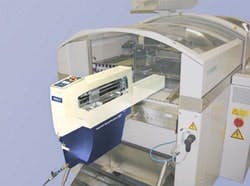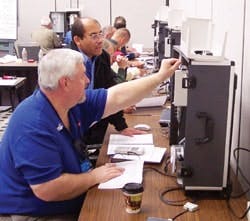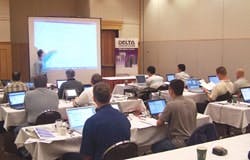What’s the best way for you and your company to ride out the recession without crippling your ability to compete when business picks up? Machine builders have some answers, as do the system integrators and vendors that serve them. Staffing is a major concern, but other issues also can take precedence.
“During a slowdown we look for cost-cutting or other design improvements in our existing products, and we also get started on offerings we think will be important when business picks up,” says Scott DeVore, Ph.D. and vice president of engineering for Data I/O in Redmond, Wash.
Data I/O’s equipment robotically handles programmable electronic devices like flash memory chips and microcontrollers. They also build in-line programmers that replace tape feeders on assembly lines (Figure 1).
Figure 1: Data I/O’s RoadRunner is a programmer-tape feeder for circuit board assembly lines that mounts directly onto surface mount technology machine. Staffing in a slowdown is a balancing act for the company, which sees the recession as a great opportunity to pick up good engineers if they have an opening.
Source: DATA I/O
“We also spend more time assisting our salespeople with additional application engineering and product customization to meet the needs of specific customers,” adds DeVore.
Staffing in a slowdown is a balancing act. “We see the recession as a great opportunity to pick up good engineers, but mainly if we have an opening. We aren’t looking to increase staff unless we can experience a near-term increase in revenue,” concludes DeVore.
Like DeVore and Data I/O, many in the industry are cautious when it comes to staffing in a slowdown.
Staffing in a Slowdown
The economy has slowed significantly, but it’s no time to abandon basic business principles about staffing. “As a mid-size system integrator with 26 employees, we’re very deliberate about adding staff,” relates Phil Murray, principal at FeedForward in Atlanta. “We hire for the long term and not for short-term project demands. Our 2009 hiring does not differ from any other time. We hire when our backlog demands it. The exception might be if a known, talented I&C person became available. In that case, we most likely would create a spot in the company.”
The key is maintaining a level of work to keep the employees actively employed, emphasizes Murray. “To that end, we recently added sales staff,” he says. “If the workload does slow down, we typically assign more people to a project and split the work among more participants. We will also do more training—both in-house and external. A key for us is to keep our good people, even during economic slowdowns.”
Some firms are adding staff. “We added an engineer a few months ago and can always add more staff,” says Dr. George Cheng, CEO of software developer CyboSoft. “Our requirements for new staff members are very high, so we tend to add them when we find them. We also see this as a good time to start major R&D projects that require focused efforts.”
Micro Component Technology in Northboro, Mass., makes strip test handlers and markers used in the back end of the semiconductor manufacturing process. “We are not planning to hire during this difficult period, but we are keeping all of our development people,” relates Dick Sidell, vice president and chief technical officer for MCT. “We also are keeping all of our automation and engineering personnel and as many applications/service people as we can.”
Sidell notes it’s critical to keep the right people during a slowdown. Core staff members are extremely valuable and notoriously hard to find, so keeping them onboard is crucial.
Keep the Core
During difficult times, a major concern for Machine Builder Nation is maintaining critical core staff. After going through many years when talent was scarce and work was plentiful, machine builders are wary of cutting staff now, only to find themselves short of talent when the upturn emerges.
Some cutbacks might be inevitable during a recession, but maintaining the core makes it easier to expand when demand picks up. “Even in a slowdown, we need to maintain the right people necessary for us to grow in the future,” says Doug Imes, electrical engineering manager with Hartness International in Greenville, S.C. Hartness makes casepackers, robotic palletizers, lane dividers, accumulators, conveyors, and video-based error-recorders.
“We need to be sure we have folks with well-rounded mechanical and electrical engineering skills to program and commission lines,” explains Imes. “They must have a willingness to work in the field, and good communication skills with internal and external customers.” Specialization is out, and versatility is in, he explains.
“We are not in a position to pick up additional staff in this situation,” notes Doug Rhodes, manager of the electrical power & automation group with Dayton & Knight in North Vancouver, B.C. “Our target is to avoid layoffs, if need be by encouraging staff to take time off. So far, the municipal sector we operate in remains relatively stable. If the situation worsens, we would want to retain those with unique skills such as wireless, unusual PLC/RTU programming knowledge, or fieldbus expertise.”
Time to Train
Most firms think it’s crucial to maintain their skilled automation professionals during a recession, but that presents a problem. Namely, what’s the best way to do less work with the same amount of people?
In a ControlDesign.com Web poll, respondents picked training as their top response. Others said they would encourage staff to take time off, retool their manufacturing and job-share.
As automation technology continues its relentless advance, training becomes ever-more important. With the proliferation of free or low-cost training, the only thing keeping many from getting the continuing education they need has been time. Now that time is more available, expect more machine builders to take the time to train.
Figure 2: ABB claims that classes with a heavy dose of hands-on programming, application and maintenance content are in high demand during economic slowdowns.
Source: ABB
“We see more demand for our training services when the economy slows,” observes Carl Henning, deputy director for PTO in North America. “Our webinars are watched more often and our one-day training classes are better attended. For many, it’s also a good time to add fieldbus or industrial Ethernet in a small project or on the bench in the lab or shop.”
Automation vendors also note an uptick in training. “Requests for training on our VFDs have increased steadily over the past several months,” says Dave Polka, training manager for the low-voltage drives & control division of ABB.
“We had requests for the 2009 training schedule back in August—several months earlier than normal. These customers push us to commit to confirmed 2009 training dates earlier than we would normally. We’ve also experienced a notable increase in inquiries regarding a combination of standard and packaged systems training for next year,” continues Polka.
Not only has ABB seen an increase in demand, it also discerns other changes in training trends (Figure 2). “During normal times, many customers relied on instructor-led courses to fill their needs,” notes Polka. “We now see more requests for a combination of formal Web-based programs and voice-over-IP on-demand training. This indicates a need for more cost-effective training strategies than traditional classroom-style offerings.”
Other vendors see increased demand for training coupled with a need to minimize training costs. “As 2009 unfolds Omron is developing an eLearning system that should help ease the pain in travel costs,” explains Dan Zeis, educational services manager at Omron Electronics. “We released courses for our internal employees and for distribution this year,” adds Zeis. “This will help minimize travel costs, but some courses will still require hands-on labs for completion.”
Figure 3: For many machine builders, slowdowns provide a great opportunity to take vendor training classes. Delta Computer Systems currently finds increased demand for training in general and for on-site classes in particular.
Source: DELTA COMPUTER SYSTEMS.
Delta Computer Systems sees an increase in interest for its motion controller training classes, particularly online. “Some of our customers are in remote locations, and they can really benefit from the cost savings of online training,” notes Bill Savela, marketing director at Delta. “We also provide remote students with access to our online motion control simulator so they can get hands-on experience”.
Another trend on the rise is to offer customized training classes at customers’ sites, says Savela. “Travel costs are reduced compared to having a group of customers visit Delta, plus on-site training has the advantage of allowing our training specialists to do demos on the customer’s machinery,” he adds.
Training is one way to redeploy employees idled by the slowdown, Sidell of MCT describes other approaches. “We’ll use scarce resources to develop product improvements that will be attractive to customers when business picks up. We use development and technical people to improve products and use salespeople to stay in front of customers to present planned improvements and to solicit requests or suggestions for additional improvements.”
Machine Builder Nation has been through recessions before and survived, and this downturn will be no different. In fact, many expect to emerge stronger through increased training and productivity improvements. After years of trying to do too much work with too few people, having a few people too many can provide opportunities to strengthen staff capabilities.
Recession Raises RebuildsFor vendors that sell components to machine builders, this is a trying time. “For our new OEM customers, the period from September to December 2008 was the worst I’ve seen in 34 years,” says Gary Corey, president of automation vendor CamSoft. “But we see an increase in demand for automation training from our retrofitter customers for replacing, fixing or upgrading existing machines. When times are good, new machinery sells well and OEMs order more of our CNC controllers. As the economy worsens, we find an increased interest to retrofit existing machinery rather than buy new.” As Corey explains it, you almost can hear the boss thinking that it’s a good time just to fix the old machine rather than buy new. “Our future could be the gold fields of the rust belt, in what we call the secondhand economy,” he suggests. “I remember hearing that about 450,000 machines in North America need retrofitting. The iron on these machines is still good, but the controls have often become obsolete.” When it comes to upgrading old machines with new controls, Corey and CamSoft favor PC-based controls. In trying economic times, the price/performance ratio of PC-based controls can be compelling. “PC-based solutions are a third of the price of traditional components,” says Corey. “We find that automation professionals turn to us for industrial quality at recession prices.” |
The Silver LiningNo one likes or wishes for recession, but some businesses are positioned to benefit from trying times. When machine builders can’t afford to maintain key staff members, the system integrator community that serves them can help in two ways. First, they are often the first to hire laid-off automation pros. Second, they are expert at deploying these new hires to assist machine builders. A good example is HilTech (www.hiltecheng.com), a system integrator in Tomball, Texas. “We see the current recession as an opportunity,” says President Lee Hilpert. “We can pick up extremely talented multidisciplinary people who have diverse backgrounds and who are looking for a challenging environment. In a normal market these individuals would be next to impossible to find.” Even in recession, these individuals still are hard to find because “they are part of the core employees that will be retained as long as possible by their employers, adds Hilpert. “But with the recession there will be companies that just don’t make the trip and some of these types of individuals will become available.” HilTech also sees the recession as a chance to pick up work from OEMs whose core business is not automation and controls. Some of these OEMs will outsource because they no longer have the critical mass necessary to profitably do this work in-house. Hilperts says he’s currently working with two major manufacturers in the oil and gas industry as a direct result of this very situation. “The challenge will be to keep them as customers when things get better,” muses Hilpert. “One way to do this is to be sure your employees are as described above. These folks can provide high-quality products and services at a price that retains business. At the end of the day it is the quality and dedication of your employees that makes your company valuable to clients.” |
Voice of ExperienceWhen contemplating a course to navigate through the perilous waters of a recession, it helps to hear from others who have been there before. Automation vendor National Instruments believes it successfully dealt with the 2001 downturn, and it plans to use the same strategy to cope with the current recession. “During the last downturn in 2001, we made a decision to continue investing in and expanding R&D resources,” explains John Hanks, vice president of industrial control and data acquisition. “I think we see the payoff of this investment, which spurred many of the technology advancements and new product offerings that have contributed to our strong growth since that time.” In addition, says Hanks, “the diversity of our business is one of our strengths during difficult times. Our sales force can adapt easily to opportunities and businesses where there continues to be investment and growth. We continue to feel good about that opportunity pipeline, and that is what gives us optimism, both in the short-term and obviously for the long-term. “We will continue to focus our investments on R&D and on expanding the field sales force while carefully managing expenses in all other areas of the business. We believe these wise and prudent investments allow us to deepen our customer relationships and expand our product portfolio, to prepare for an eventual recovery.” Hanks says there are no plans to cut staffing and that NI always looks for people with expertise in new areas of expansion. “During difficult times, it is important to give clear direction and deadlines on inspiring projects that make a difference,” he states. “It is also a time to raise the bar on skills and professional development within the group.” |
Keep Busy During the Slowdown1. Step up training, especially through free, local and/or Web-based classes 2. Implement new machine automation systems 3. Accompany sales people when they make calls on new and existing customers 4. Retool manufacturing 5. Implement new internal software and hardware systems to improve productivity |
Positive Things To Do During the Recession1. Stay close to the 20% of your customers who typically provide 80% of the business. They will remember you when things turn around. 2. Review your website and give it a face-lift if necessary. Be sure to benchmark your site against the sites of your competition and others within the industry. 3. Provide sales and marketing staff with training on new products, new technologies, like wireless, or new strategies. 4. Update or enhance marketing materials such as PowerPoint presentations, brochures and mailers. 5. Attend local industry trade organization meetings and events—if you stay local the travel cost is low, and it is a great chance to network. Courtesy of CJM Consulting |
The Time Is NowYour company might be among those planning to implement new software and hardware products to improve productivity. Your company might also be among those whose plans were postponed because everyone was just too busy. Mark Taylor, executive vice president and general manager of Eplan Software & Services, says many of his customers see the recession as an opportunity to implement new software systems. “The No. 1 speed bump in implementing new software or systems is the time required to ensure a successful rollout,” says Taylor. “Productivity gains in engineering are paramount for surviving economic changes, and focus on efficiencies and productivity tends to be sharper during economic downturns.” One problem with implementing productivity enhancing software and systems during a downturn can be the up-front acquisition costs. But many firms already have systems in place that are not being fully exploited. “Downturns allow for expansion and enhancements to investments that started out well but never reached full potential,” adds Taylor. “This typically occurs because the plan that was set out at the beginning was not enforced because everyone was too busy.” Some firms plan to use the extra time created by the slowdown to revise their machine control system architectures. For these companies, implementing these new designs with new engineering tools and practices can “double the bang for their buck by eliminating duplicate efforts,” believes Taylor. |

Leaders relevant to this article:








